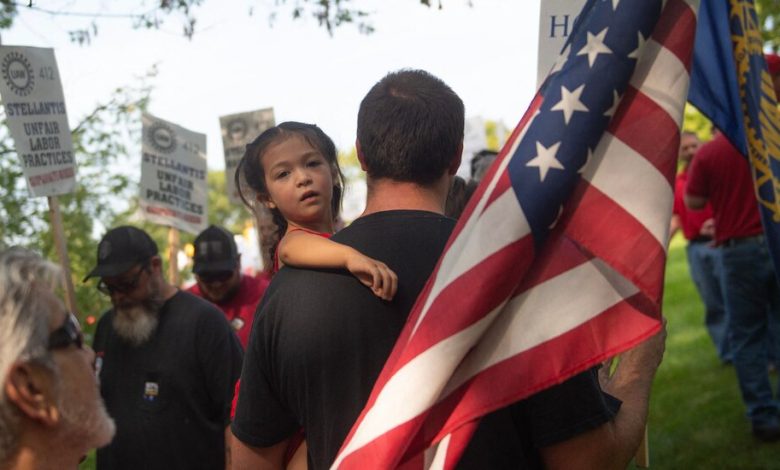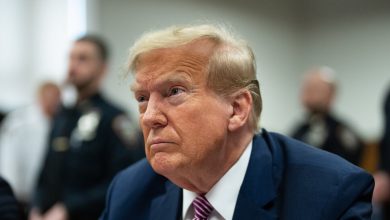Why Unions Are Good for America

As the United Automobile Workers strike continues, we’re likely to hear grumbling about labor unions.
“They killed the auto industry once, and now they’re trying to do it again,” some will say. Or “They’re corrupt.” Or “They’re Luddites resisting modernization.”
Sure, there’s something to criticisms of unions. Yet the critiques miss a fundamental point: Labor unions are also a powerful force for equality, elevating underpaid workers who otherwise are often treated as doormats.
The central reality is that as unions declined over the past half-century, workers were stiffed. They were paid poorly, they lost health care and retirement benefits, and they lost control over their schedules. They were robbed of dignity and sometimes of wages as well. Deaths of despair from drugs, alcohol and suicide surged among blue-collar workers.
Anne Case and Angus Deaton, the Princeton University economists who pioneered the study of deaths of despair, tell me that one factor in the rise of such deaths has been the decline of unions and the related loss of good working-class jobs.
Like many educated professionals, I used to regard labor unions warily. They insisted on rigid work rules, impeded technological modernization, suffered corruption scandals (which have dogged the U.A.W.) and sometimes engaged in racial and gender discrimination. They periodically manipulated overtime hours and leveraged the threat of disruption to rake in staggering sums.
In 2019 two Oakland, Calif., police officers “earned” more than $600,000 in pay and benefits, through absurd amounts of overtime; meanwhile, full-time dockworkers on the West Coast reportedly earn more, on average, than many lawyers or dentists in America, and dock foremen average more pay than physicians.
Yet executive pay seems even more scandalous, and I shed my disdain for unions as I reported on the crisis in America’s working class over the past 15 years. Having lost too many working-class friends to substance use and related pathologies and having witnessed the consequent crumbling of families and communities, I’ve come to believe that unions are good not only for individual workers but also for America itself.
Some of the U.A.W.’s non-wage-related demands seem to me unrealistic, and the overall package might double labor costs for companies that already pay significantly more than their competitors; then again, it’s not obvious to me why the Big Three’s chief executives merit pay packages of more than $20 million each while some of their autoworkers earn just $16 or $17 an hour, although in fairness, Ford says that, including benefits, the average compensation for union-represented workers is $112,000 a year.
(Anyone who thinks that executive pay is invariably calculated through an arms-length negotiation doesn’t understand board behavior. As the economist John Kenneth Galbraith observed, the paycheck “is frequently in the nature of a warm personal gesture by the individual to himself.”)
The golden age for unions in America was the period from 1945 to 1970, and there were indeed abuses and disruptive strikes then. But that was also a magical period in American economic history, in which the economic pie grew rapidly and was also divided more fairly. Shareholders benefited, but so did workers, including African Americans at the bottom of the economic ladder.
In 1970, unions still represented 29 percent of private-sector workers. Now they represent just 6 percent. Over the decades, blue-collar workers lost a path to the middle class, and pay gaps for Black men yawned as great as ever.
So I’ve come to think of it this way: Unions are as imperfect as capitalism itself, and just as essential.
A major study by academic economists found that union households earn 10 percent to 20 percent more than nonunion households, controlling for other factors, and researchers have found that higher wages for union members spill over and lift earnings for nonunion members. Those scholars found that about 10 percent of the increase in American inequality since 1968 was a result of falling union membership.
Another study found that lifetime membership in a union resulted in an additional $1.3 million in income over the decades compared with the income of someone in the same industry who was not a union member.
While unions unchecked sometimes behave badly, consider what corporations do unchecked. Millions of Americans are addicted to opioids in this country because pharmaceutical companies found it profitable to get people hooked.
We need checks and balances to rein in overreach by both sides — and unions are part of that system of watchdogs. Yet in recent decades laws have impeded unions, and a lame National Labor Relations Board essentially allowed union busting because penalties were so pathetic. (That appears to be changing under President Biden.)
Unions have also been powerful advocates of policies like early childhood education, child care, a higher minimum wage and a refundable child tax credit to take on the scandal of American child poverty.
So it’s reasonable to worry about the autoworker strike and the impact it might have on today’s economy. It’s fair to wonder if the U.A.W. is overreaching, particularly in its nonwage demands. Then again, it’s also reasonable to worry about what happens when nonunionized blue-collar workers are squeezed and crushed, year after year, decade after decade, and what that does to their children, to their country, to our future.
The Times is committed to publishing a diversity of letters to the editor. We’d like to hear what you think about this or any of our articles. Here are some tips. And here’s our email: [email protected].




